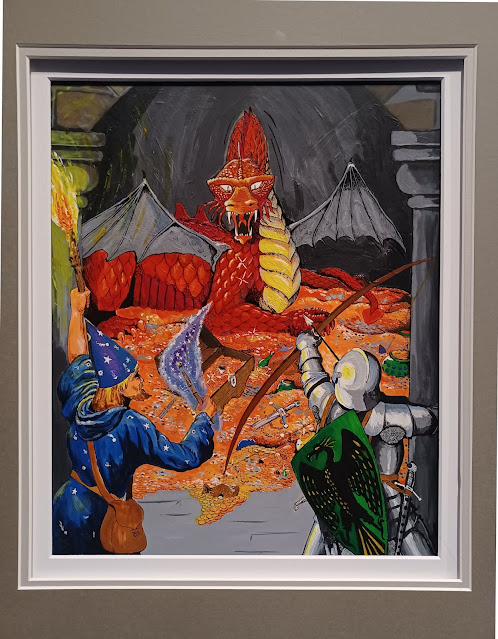This is an installment of The Forgotten Smugglers' Cave, which starts at Area 1.
|
Area 9
||
|
|
| Sea ===C |
10. DRIFTWOOD HERMITAGE |
|
|
(C = concealed) |
|
10. DRIFTWOOD HERMITAGE. This water-filled cavern is the home of a were-shark that lairs in a hut on a ledge on the eastern side.
Entrance. The only practical way to enter this cave is via the half-water-filled passage from Area 9 to the north. This passage opens up to the north end of a large natural cavern, dimly lit during the day via cracks in the ceiling, and also filled with water. The cavern is 50 feet wide (east-west) and extends 90 feet to the south. On the eastern side, a wide rock ledge rises two feet from the water, and on this rests a large wooden hut built against the cavern wall. The ledge extends twenty feet out from the wall.
Underwater Tunnel. The only other exit from the cavern is submerged ten feet beneath the surface of the water in the west wall, where a ten-foot wide underwater tunnel leads several hundred feet to the west to the sea.
Water and Inhabitants. Throughout the cavern, the water is 20 feet deep, and anything entering it will attract the attention of 4 cave sharks that lair here in association with the were-shark. From a watercraft, there is a 2 in 6 chance each turn of spotting the back fin of one briefly breaking the surface. If anyone enters the water, they will begin circling them, but will not attack unless the person is already injured or Mar Nes summons them to his aid.
Cave Sharks (4): DX 12, HD 3 (hp 12), HD 2 (hp 7, 8), HD 1 (hp 4), AC 6, AT 1 bite for 1d6
If the PCs enter during the day, roll a d6 to determine where Mar Nes the Hermit, a former crabber who is now a were-shark, is currently located:
1-3: in the shelter, asleep.
4: in the shelter, awake.
5: swimming underwater, and immediately aware of the party.
6: out of the cavern, with a 1 in 10 chance of returning each round.
At night, Mar Nes will typically be out in the sea hunting for fish.
Ledge and Hut Exterior. The ledge rises nearly straight from the bottom, so a boat can easily be pulled up alongside it.
On closer inspection, the hut is built from large driftwood and decorated with a variety of sea shells. At one end sits at pile of old crab traps. A curtain of old ropes serves as a door, to the back of which are tied several buoy bells that will clang loudly if passed through.
The Hermit Crabber. If the hut is approached and Mar Nes is awake, or awakened by someone attempting to enter, he will cry out that they should speak through the door as he has a contagious skin disease (e.g., leprosy). This is not true, although his rough skin does have an unnatural grey tone. He will also give a fake name (Grink) that townsfolk will not recognize, and claim to have climbed down here years ago through a crack in the ceiling that is no longer accessible.
While not pleased to have his lair discovered, Mar Nes is inquisitive and will try to learn more about the PCs by acting the part of a hermit. He will trade information about the caves for food (other than seafood) or alcohol. Being a smuggler in his youth, he knows the general layout of the cave system prior to the cave-ins, including the tunnel above the waterfall in Area 9. He also knows of the Sea Changed in Area 8, which he avoids, and how to slow the change with daily application of vinegar.
However, if any character possesses the unholy symbol from Area #7, there is a 1 in 6 chance each round that it will trigger Mar Nes changing into were-shark hybrid form and charging forth in an attempt to take it.
In truth, after decades successfully crabbing out of Portown, Mar Nes was bit by a were-shark when pulling up a crab trap. He fended it off with his lucky silver knife, but was infected with lycanthropy. Abandoning town, he remembered these caves and found this spot to lair in, hunting for fish in the sea at night. Due to his force of personality, he has maintained a fair degree of control over his lycanthropy. He occasionally returns to Portown in human form to sell old treasures from shipwrecks for money for his family, and to bring pretty seashells to his beloved young great-granddaughter.
Mar Nes the Were-shark: DX 6 on land, 15 in water, AC 5, HD 4, HP 26, #AT 1 bite for 2d6/1 tail slap (only against a second opponent) for 1d6 plus drop anything held on 1-2 in 6), immune to normal weapons in shark or hybrid forms
A full monster entry for were-sharks can be found here.
Hut Interior. Inside are rough furnishings, including a sleeping mat and sitting logs. Hidden behind a loose rock in the back wall is a cavity holding a barnacle-encrusted gold brooch worth 50 gp, or double that if properly cleaned, several seashells, and an oilskin wrapping holding drawings made by a young child.
There is only one above-water exit from this area, which is the passage from Area 9. There is also a tunnel concealed underwater that leads west several hundred feet out to the ocean.
Chronologically on this blog, the previous post installment was Area 9 and the next posted installment will be Area 11.




